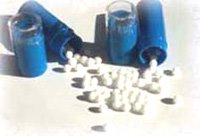Why homeopath potentised their medicines?
Potentisation is a physical process by which the latent curative properties of drug are brought into activity. This process was introduced by Hahnemann himself, in the fifth edition of Organon of Medicine, in 1833.
Potentisation helps to explore the dynamic curative properties of the drug or substance which is normally inert.
Potentisation was a new thought of Hahnemann, which not only preserve the therapeutic potentiality but increases the pharmacological and therapeutic activity.
To minimize the drug effects of the material doses, Hahnemann started the new method of dilution.
Whether a substance has a physiologically nutritive value or inert or poisons or narcotic in their crude state, potentisation has helped to explore their therapeutic potentialities and helped the mankind by their curative values. Nat Mur (common salt), Silicea (flint) has been listed as a valuable medicine by potentisation. Potassium cyanide, Arsenic, Mercury are highly harmful to man but have become good remedies in dreadful diseases when selected according to symptoms similarity.
Apart from the known chemical and physiological action the potentisation has changed its character and made it easily tolerable to the human system. Arsenic; podophyllum in large doses produces diarrhea and vomiting but in potentised form it produces different effects.
The more a drug is potentised the greater its dynamic medical power increased to an incredible degree.
Each and every substance has its own peculiar or characteristic properties, e.g. ‘External’ or ‘Physical’; ‘Chemical’ and ‘Dynamic’. With the help of our external sensitive organs, e.g. eyes, ears, nose, tongue and skin (by touching) we recognize and understand many substances, and can differentiate one substance from another. Everybody knows that most of the strong acids are corrosive in their crude state; Arsenic album, Podophyllum, Veratrum album, produce diarrhea and vomiting in large doses, all sedatives produce sleep in their crude states. By testing their chemical actions on human system in heavy doses drugs of one action group can be differentiated from another group. All the drugs of one action group behave similarly producing some respective effects or symptoms on human beings. But only by their chemical properties or actions, differentiation between the drugs of even one action group is not possible, not to speak of drugs of other action group or all other drugs.
By applying crude drugs in large doses, all the therapeutic values of drugs can not be differentiated properly. But in their finer doses, the symptoms or effects produced by them help us to differentiate one drug from another, whichever action group or source they may belong. The properties by which one drug can be properly recognized from any other drug are dynamic properties. These dynamic properties of drugs are aroused by the homeopathic process of potentisation. By this process many latent virtues or properties of drugs, hitherto unknown, are discovered and explored and utilized, which is not possible in their crude form or by their chemical actions.
Initially Hahnemann used to administer homeopathic medicines in large doses, but observing the unnecessary medicinal aggravations, he had to minimize and dilute the doses later on. By a continued process of reducing the material quantity of a drug he demonstrated that medicines in potentised forms produce no violent or injurious aggravations.
Hahnemann observed” The effect of friction is so great that only the external physical properties such as odor, color etc. are aroused and developed by it, but also the dynamic medicinal power of natural substance, are hereby called forth to an incredible degree”.
There are two processes of potentisation:
1. Succussion- By this process the dynamisation of the liquid drugs is made. For this purpose three scales are in use: (a) Decimal, (b) Centesimal, (c) 50 Millesimal.
It is the method of potentising soluble drug substances. It may be in water and alcohol or a mixture of both. Generally alcohol is used in most cases, except in cases where the drugs are soluble only in water. In latter cases also alcohol is used, after attaining certain degrees of attenuations. In making liquid attenuations or dilutions, the shaking is done with definite proportions or water or alcohol or a mixture of the both for a number of times or minutes, in definite manner, for preparing the next higher potency.
The process of succussion is entirely different from simple mixing and agitating. The process of succussion is a new invention of Hahnemann at the renaissance period of 18th century. At a dilution of 1/10^24 corresponding to potencies of 12c or 24x, AvogardoLimit has been reached, beyond which there are theoretically no molecules of original substances left in the preparation. However it is clinically and experimentally demonstrable that such potencies are still pharmacologically active and preserve the therapeutic potentials of the original substance. The method of potentisation causes the pharmaceutical message of the original drug to be impressed on the molecules of the diluent. They may involve a polymerization or an electromagnetic effect.
2. Trituration- This is used for drug substances, which are insoluble in liquid vehicles. An ideal process for the trituration of medicines is by using milk sugar as vehicles, and made by constant rubbing through. Two scales are in use for trituration: (a) Decimal, (b) Centesimal.
Trituration has the capacity to reduce and to breakdown the drug particles to the finest possible particles. By trituration the surface tention of a drug is increased enormously. For example, a cube of 1cm has a surface area of 6sq. cm; if this cube be further divided in cubes of ½ cm then the total surface area will be 12sq. cm. If these cubes be sub-divided in further small cubes, the relevant surface areas will increase proportionately. By gradual increasing sub- divisions of these small cubes, the surface area may be extended to the extreme. The catalytic effects, colloidal properties and the absorptive qualities of drugs increase proportionately with the increase of the surface area.


